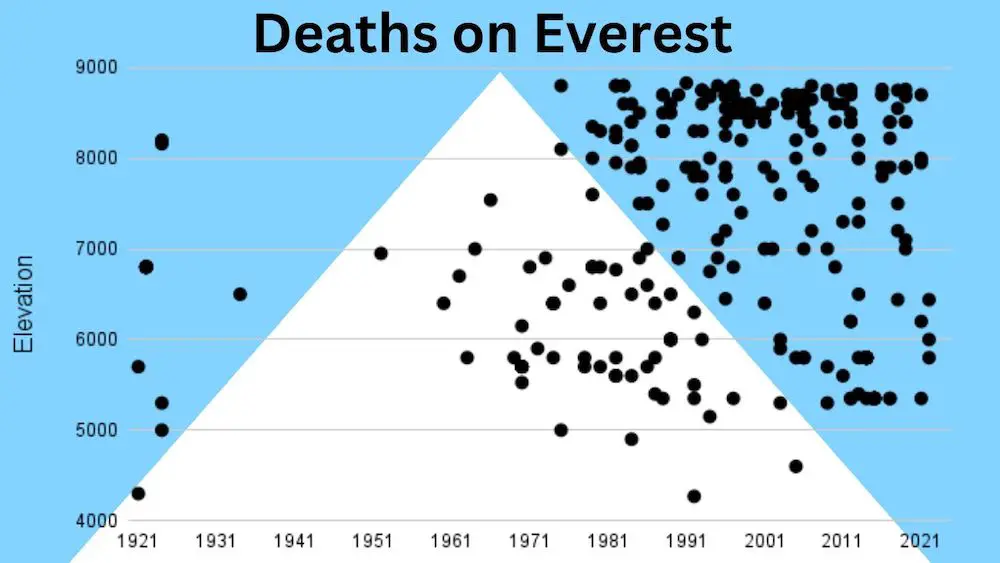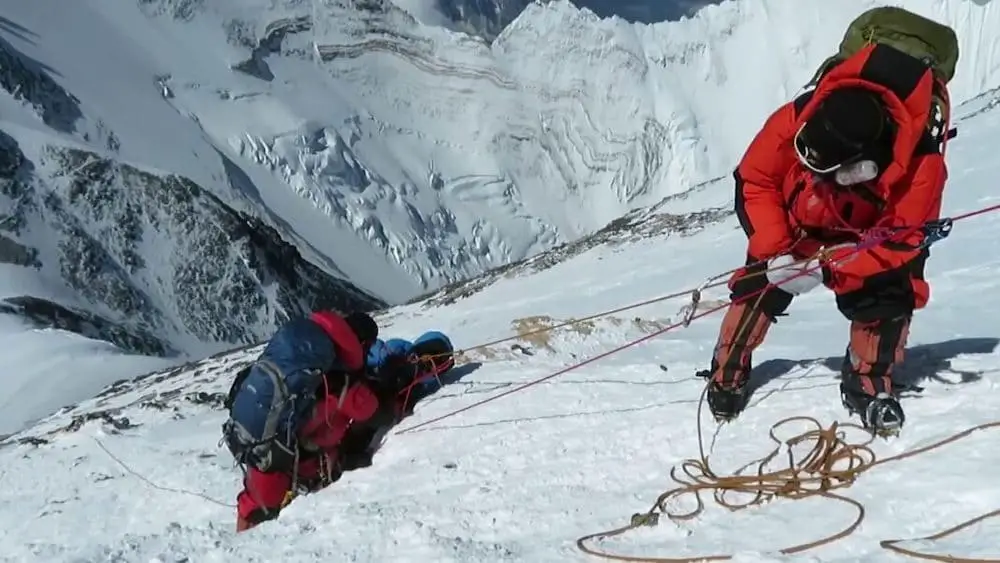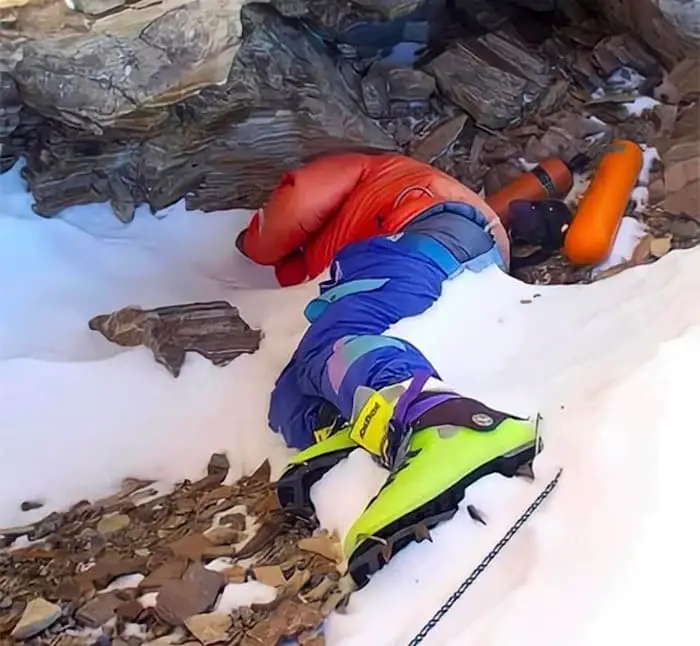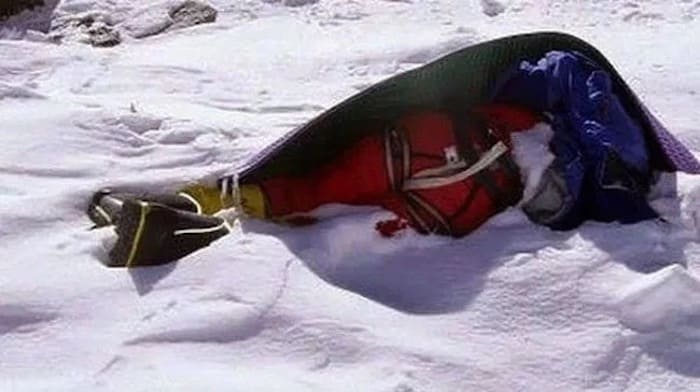The world’s tallest mountain, Mount Everest, is also one of the most dangerous and exciting destinations for trekkers. Unfortunately, death on Everest is extremely common for would be climbers. The dangerous mountain has led to over 300 deaths, and 200 dead bodies on Everest.
The highest in the world, climbing this mountain is the ultimate test for expert mountaineers, inexperienced climbers and courageous beginners. Glory among their fellow mountaineers is waiting for those who succeed. Typically with the aid of paid professional sherpas familiar with the difficult terrain.
However, a lot of these climbers never return from the mountain. Have you ever wondered what happens to the dead bodies on Mount Everest? Let’s start by looking at how many dead bodies are on Mount Everest.
Want to watch a video covering: Death on Everest and what happens to the dead bodies, instead?
Death on Everest: What’s The Body Count?
More than 200 dead bodies are believed to be on Mount Everest—some along popular routes, while others are lost in crevasses. Between 1922 and 2022, at least 310 climbers are known to have died while climbing Mount Everest.
At 26,000 feet above sea level, the extreme air pressure and low oxygen levels make it easy for climbers to succumb to the elements and die. There’s a reason this place is called the death zone. To see a full list of deaths and Mount Everest bodies on the mountain, check the list here.
When the body utilizes oxygen more quickly than it can replace it, physical functions decline, people faint and eventually die. And it doesn’t account for the ongoing danger of slips, trips, and falls; avalanches; ice collapses; exposure to freezing temperatures and wind; or natural disasters.
The Surreal Scene Of Passing Dead Bodies On Everest While Climbing
If you’re preparing to climb Mt Everest, encountering a disturbing scene should not alarm you: a dead climber on the path wearing mountaineering gear.
This is due to the fact that Mount Everest has over 200 dead bodies still lying on the mountain. The image below is an Everest body map. It depicts where deaths occurred on Everest in terms of elevation and year.

Many climbers have remained permanently on the mountain; one of them even serves as a sad monument. The unlucky climber known as “Green Boots,” is the Indian climber Tsewang Paljor. He has been atop the mountain since 1996 when he perished during an expedition.
Why, then, have so many people remained on Mount Everest as their ultimate resting place? Well, to start with, the mountain is incredibly high. Meaning that retrieval missions can be extremely dangerous and costly.
Of course, there are family members of individuals that pass away on Mount Everest who would wish to have their loved ones’ bodies taken down for a proper burial. However, due to the danger as well as cost many families opt for mountain burials for their loved ones bodies on Mt Everest.
Does Mount Everest Use Bodies as Markers?
No, Mount Everest does not use bodies as markers. Unfortunate instances have occurred where climbers lost their lives on the mountain. Emphasizing that climbers do not intentionally leave their bodies behind as markers or waypoints is essential. However, areas on the south col and other regions like the Rainbow Valley, are covered with frozen bodies that climbers use to signal their location.
Discouraging and considering it disrespectful to leave bodies on Mount Everest, climbers make efforts to recover and bring down the deceased. However, the extreme conditions and high altitude of the mountain can make it impossible to retrieve them at times.
Why is Removing The Bodies a Difficult Task?

Dead bodies are the most attention-grabbing topic around Mount Everest. Since 1924, a total of 310 people have lost their lives on both sides of the mountain. Nepal and China have both expressed intentions to remove the remains of more deceased climbers in the coming years.
The task of removing bodies is physically demanding as they have frozen into the mountainside over time. For the rescue teams, the missions are typically unpredictable and hazardous. While some pay teams to retrieve loved ones’ bodies, the cost can be around $70,000, often beyond families’ budgets. Rescue missions can also be deadly for the rescuers as well. Whereas, in one infamous mission to recover the body of Hannelore Schmatz in 1984, two Sherpas lost their lives.
Ethical Dilemmas and Sacred Beliefs Surrounding Mount Everest
It is also controversial, conflicting with various traditions and beliefs surrounding Everest. While many climbers prefer to have their bodies left on the peak, sometimes families desire recovery for closure. The Sherpa communities, on the other hand, view leaving the dead on Everest as disrespectful to the mountain gods.
For instance, in 2010, objections from the Nepalese government and locals halted a plan to scatter Sir Edmund Hillary’s ashes on the summit. They argued that Everest should not be used for publicity due to its sacred nature.
A warming planet makes the issue more urgent, exposing long-buried bodies when glaciers melt. This phenomenon occurs not only on Everest but also on mountains around the world. For instance, in 2015, the glacial slopes of Mexico’s Orizaba revealed the corpses of three climbers who had died decades ago.
What Happens To The Bodies on Mount Everest?
Everest’s peak experiences year-round lows that are considerably below zero. Moreover, the mountain’s average temperature fluctuates from a frigid minus four Fahrenheit to a lethal minus thirty-one Fahrenheit. These temperatures create a unique environment for both the living and the dead.
The Everest region is inhospitable to life because anything left there for an extended period of time will freeze solid. This is exactly why bodies on Everest are so frightening for climbers who see them. Apart from cellular damage due to extreme cold, the bodies freeze in place and usually retain their appearance since their time of death.

Additionally, considering how little flesh climbing gear leaves exposed, climbers see Everest bodies every year. They sometimes report them as looking remarkably similar to when they lost their lives. A body virtually anywhere else would be little more than a skeleton after a few years.
Climbers never know exactly who they’ll run into on their journey. Lhakpa Sherpa, a climber, found herself in that situation. She holds the record for the most summit visits by a woman, having encountered eight corpses on her 2018 ascent. Even more unsettling, one appeared to be alive, with the frozen body’s hair waving in the choppy Everest winds.
How Long Do Bodies Take To Decompose on Everest?
On Mount Everest, the extreme high-altitude environment significantly delays the natural decomposition process of human bodies, often preserving them for years or even decades. The low temperatures, sparse oxygen, and limited microbial activity at such heights slow down the decay of organic matter.
Explorers found George Mallory’s well-preserved body in 1999, 75 years after his disappearance due to frigid conditions. Another notable example is the remains of “Green Boots”. He has been visible in a limestone cave on the Northeast Ridge route since 1996.
These instances demonstrate how the harsh climate of Everest can essentially mummify bodies, offering a unique insight into the preservation of human remains under extreme conditions.
The Growing Concern of Frozen Bodies on Mount Everest
In 2014, an avalanche took the lives of 16 Nepali mountain guides. A year later, a devastating earthquake in 2015, at the base camp claimed the lives of 19 climbers. The Himalayan Database, an organization that tracks mountain and climbing data, has recorded that over 300 climbers have lost their lives in the Everest region to date.
Nepali mountain guides involved in the climbs state that numerous bodies still remain in the upper camps of Everest. Encountering these bodies often demoralizes climbers on their way to the summit. During the 2023 season alone, 17 individuals lost their lives on Everest. Among these cases, eight bodies were appropriately handled, while the remains of the other nine deceased climbers were left on the mountain, according to information provided by the tourism department.
Due to constant snowmelt attributed to climate change, human skeletons—remnants of climbers from past years—are now resurfacing at the base camp. Seasoned climbers note that such sightings have become quite common over the past few years.
Climate Change on Everest – Hidden Bodies Becoming Visible

However, recent developments have made this frozen cemetery a more urgent issue. With global warming and as the earth warms, many locations that were once completely hidden by snow are becoming visible.
As the snow melts in the summer months, long-buried bodies that might not be in great condition are revealed. Climbers claim that dismal discoveries on the peak are becoming more frequent.
It’s not uncommon to find old bones and even entire bodies. This could enable some families who lost loved ones on the mountain to find closure. But it could also further harm Everest’s natural beauty. Additionally, if the mountain’s thick ice cap keeps melting, it might become considerably harder to ascend.
Because of this, Nepal and China are considering taking action. The tourist ministry of Nepal has gathered the names of long-missing climbers and dispatched volunteers to collect garbage and bodies. However, doing so is still dangerous and only occasionally undertaken.
Climbers and Locals Calling for Action
However, some supporters of the mountain are calling for more extreme action. Every spring during the peak climbing season, a thousand or so international climbers attempt the mountain. All in an effort to add to the more than 8,000 climbers who have succeeded in reaching the summit since 1953.
However, many more will fall short along the way, some will pass away, and many will leave behind more rubbish.
Many climbers utilize their climb to raise money for charity. The Nepalese government charges a levy to each climber to protect the mountain. However, more individuals are debating if the ritual of ascending the mountain is doing more damage than good.
They contend that in order to prevent further deterioration and damage, it may be necessary to ban foreign visitors. And, to avoid the number of permanent residents on Everest from growing.
2023 Update about Death on Everest:
The return of monsoons and high winds to the Khumbu Valley marked the unofficial conclusion of the 2023 spring climbing season on Mount Everest. These weather conditions have closed the window of favorable weather on the world’s highest peak. Unfortunately, 2023 has been characterized by chaos and tragedy. Prompting climbers and Everest expeditions to reflect on the immense challenges they faced.
As of July 1st, reports show that 12 climbers have lost their lives including three in the Khumbu Icefall. Five climbers remain missing. The current death toll ranks as the fourth-highest in Everest’s history, surpassed only by the years 2015, 1996, and 2014, which saw 13, 15, and 16 fatalities respectively. If authorities declare the five missing individuals deceased, the climbing community will remember 2023 as the deadliest year on this peak, with a total of 17 fatalities.
FAQs: Death on Everest
Everest is a major accomplishment in many climbers’ lives. However, for some, the adventure ends up being their final resting place. This section answers some of the most frequently asked questions regarding death on Everest.
No, they do not decompose. In less than four hours after passing away, most bodies freeze to the slope. Due to the temperature, these corpses remain frozen 365 days a year. As a result, the mountain’s conditions have preserved most bodies almost completely, despite their abandonment for years.
As it is customary to leave the deceased where they are, bodies are left on the mountainside to spend eternity as both ghastly mile markers and a warning to climbers. Nearly every climber had to cross one of the most famous corpses, “Green Boots,” to get to the summit.
Unfortunately, taking bodies down the mountain is extremely dangerous and costly. Therefore, if someone meets their untimely death on Everest, their body will be left there to be frozen in time.
On May 1, 1999, the oldest known body was discovered on Mount Everest. Seventy-five years after his 1924 death, George Mallory’s body was found following an abnormally warm spring. George Mallory had sought to be the first person to summit Everest. However, he vanished before anyone found out if he had summited or not.
Green Boots has been on Everest for almost 25 years. Someone buried the body with snow and stones at the family’s request. Between 2014 and 2017, nobody saw Green Boots. However, the body became visible again in 2017 as the snow melted away.
It is dangerous work to remove bodies from the death zone. Moreover, it is expensive, dangerous, and extremely hazardous for the Sherpas who are assigned to retrieve the bodies from Everest.
In 2014, a Chinese team removed Green Boots’ body from the his famous resting place in the cave. The body is still on Everest but has been moved out of sight and is now much harder to locate.
